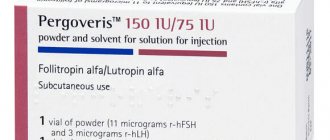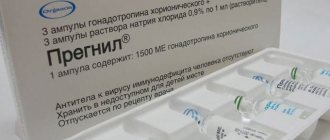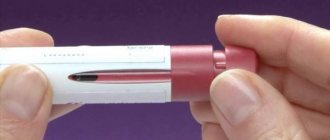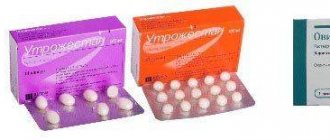Release form and composition
Dosage forms:
- Solution for intramuscular and subcutaneous administration: colorless, transparent (in colorless glass bottles of 0.5 ml, 1, 5 or 10 bottles in a cardboard box);
- Solution for subcutaneous administration: colorless, transparent (in colorless glass cartridges of 0.36, 0.72 or 1.08 ml (300/600/900 IU), 1 cartridge in a cardboard box complete with needles - 6 pcs. ( 300/600 IU) or 9 pieces (900 IU)).
1 bottle (0.5 ml) contains:
- Active substance: recombinant follitropin beta - 100, 150 or 200 IU (international units);
- Auxiliary components: polysorbate 20 - 0.1 mg, sucrose - 25 mg, sodium citrate dihydrate - 7.35 mg, methionine - 0.25 mg, sodium hydroxide 0.1 N or hydrochloric acid 0.1 N - up to pH 7, water for injection – up to 0.5 ml.
1 cartridge includes:
- Active substance (0.36/0.72/1.08 ml): recombinant follitropin beta - 300, 600 or 900 IU;
- Auxiliary components (0.36/0.72/1.08 ml): polysorbate 20 – 0.105/0.177/0.234 mg, sucrose – 21/39/58.5 mg, sodium citrate dihydrate – 6.17/11.5/ 17.2 mg, methionine – 0.21/0.39/0.59 mg, sodium hydroxide 0.1 N or hydrochloric acid 0.1 N – up to pH 7, benzyl alcohol – 4.2/7.8/11 .7 mg, water for injection – up to 0.42/0.78/1.17 ml.
Using a syringe pen
How to inject Puregon using a syringe pen? First you need to warm the cartridge to room temperature if it was stored in the refrigerator. Then release the pen from the cap and detach the cartridge holder. Inspect the cartridge and make sure that the solution in it is completely clear.
Then you need to disinfect the open tip of the pen and screw the needle cap onto it. Then you need to set the required dosage of the medicine by turning the wheel with numbers - for example, 250 IU. If you accidentally miss the correct number, do not try to turn the wheel back. Reach the zero mark and turn again to the desired number.
Then lift the pen vertically, click your finger and use the plunger to squeeze out a few drops of the solution - that is, you need to remove air bubbles from the liquid with this action.
After this, disinfect the skin on the abdomen, remove the cap from the needle, pull back the fat fold with two fingers and insert the needle into the skin at a right angle. Now you need to press the injection button with your right hand and wait for a zero to appear in the window and a click - you have injected all the medicine.
What should you do next? Wait a little (count to five) and pull the needle out of the skin. After this, immediately disinfect the puncture site with alcohol or aseptin - a medical wipe with alcohol will also work.
Now put the cap on the needle, unscrew it and dispose of it in the trash. Then disconnect the used cartridge and throw it in the trash. Cover the handle with a lid and put it in the refrigerator. You can immediately insert the cartridge into the pen, or you can do this immediately before the injection.
What to do if there is not enough medicine in the cartridge? You need to replace it with a new one or add the missing amount of medicine using an additional injection. In this case, you must keep strict records of the administered doses of Puregon.
Is it possible to make intramuscular injections with a pen? The device is intended for subcutaneous administration, however, injecting the medicine into the muscle is also acceptable - but not advisable.
Cartridge storage
How to store Puregon in a cartridge? If you have not opened the cartridge, it can be stored in the refrigerator until the expiration date. The cartridge can also be stored in the house if the air temperature does not exceed 25C. In this case, the period for selling the medicine does not exceed three months.
Note! The cartridge should be stored in a place protected from the sun. They cannot be placed in the freezer.
If you open the cartridge, the shelf life does not exceed a month. Remember that you need to store the cartridge in a closed state, that is, in the cap. Do not leave the pen with a used or new needle attached. Injection needles are stored in caps covered with film.
Two women cannot use the same pen and cartridge - this is a device for individual use. The pen can last for a long time - it is designed to perform 300 injections. Then you need to buy a new pen.
If you need to administer 50 IU of medication, purchase a 300 IU cartridge. If your single dose is 100 IU, it is better to buy 600 IU cartridges. If you don't have enough injection needles, you need to contact your doctor.
Pharmacological properties
Pharmacodynamics and pharmacokinetics
Puregon contains recombinant follicle-stimulating hormone (FSH), obtained through recombinant DNA technology. It uses a Chinese hamster cell culture into which the genes of human FSH subunits are integrated. The primary acid sequence of the recombinant DNA coincides with that of natural human FSH. However, slight differences in the hydrocarbon chain structure were detected.
FSH is responsible for the production of sex steroid hormones, normal growth and maturation of follicles. The concentration of this substance in the body of women is a factor that determines the onset and duration of follicle development, as well as their number and time of maturation. For this reason, Puregon is used to stimulate estrogen synthesis and follicle formation in certain ovarian dysfunctions. The drug is also prescribed to induce the development of multiple follicles during artificial insemination (for example, during intracytoplasmic sperm injection, intrauterine insemination, in vitro fertilization/embryo transfer techniques).
After drug therapy, human chorionic gonadotropin (hCG) is usually administered to induce the final stage of follicle maturation, resumption of meiosis and ovulation.
In some cases, Puregon is prescribed to men to treat FSH deficiency, leading to impaired spermatogenesis. For such indications for use, a combination of the drug with the administration of hCG is recommended, and the duration of the course of therapy should not be less than 4 months.
After subcutaneous or intramuscular administration of Puregon, the maximum level of FSH in the blood plasma is recorded after 12 hours. In men, after an intramuscular injection of the drug, the maximum level of FSH in the blood is achieved faster than in women. Due to the gradual entry of recombinant follitropin beta into the body from the injection site and a long half-life (12–70 hours, average 40 hours), FSH concentration remains elevated for 24–48 hours. Subsequently, repeated administration of the same dose of the hormone causes a further increase in the level of FSH in the blood by 1.5–2 times compared with a single administration. This makes it possible to achieve the required concentration of FSH in the blood.
With intramuscular and subcutaneous administration of Puregon, the pharmacokinetic parameters remain almost the same. In both cases, the bioavailability of the drug is approximately 77%. Recombinant FSH is biochemically identical to FSH found in human urine and is similarly distributed, metabolized, and excreted from the body.
Patient reviews
Vladislava, 27 years old : “When I was being prepared for IVF, Puregon was prescribed. A very expensive medicine, but it's worth it. My injections with Puregon went through a short protocol, so by the end of the week the puncture was already performed. The puncture showed 22 mature follicles, seven were fertilized and two of them were replanted. Two weeks later I found out about my long-awaited pregnancy.”
Irina, 31 years old : “I also have experience with the drug. I used a special syringe pen with Puregon. Conveniently, the sensor measures the required dose. Considering that Puregon is very expensive, every milligram can be counted. I was very afraid to give myself injections, but it turned out that it was not scary and not difficult.”
Indications for use
Puregon is prescribed for the treatment of female infertility in the presence of the following indications:
- Induction of superovulation - to induce multiple development of follicles during artificial insemination (for example, in in vitro fertilization/embryo transfer (IVF/ET), intrauterine insemination (IUI) and intracytoplasmic sperm injection (ICSI) techniques);
- Anovulation, including polycystic ovary syndrome (PCOS) with insensitivity to clomiphene.
Drug interactions
The therapeutic effectiveness of Puregon can be reduced by parenteral and enteral administration of Diferelin, Zoladex, Buserelin, Lucrin-Depot. In this case, the dosage of the drug is increased.
Photos of drugs:
Zoladex
Lucrin-Depot
Buserelin Diferelin
Together with Clomiphene, it enhances the ovarian response.
Puregon is pharmaceutically incompatible with other drugs.
Contraindications
- Anatomical disorders of the genital organs that are incompatible with pregnancy;
- Severe functional disorders of the liver/kidneys;
- Bleeding (vaginal/uterine) of unknown origin;
- Tumors of the uterus, mammary gland, ovaries, hypothalamus, pituitary gland;
- Ovarian cysts/enlargement not associated with polycystic ovary syndrome;
- Uterine fibroids incompatible with pregnancy;
- Primary ovarian failure;
- Decompensated diseases of the endocrine system (for example, disorders of the thyroid gland, pituitary gland or adrenal glands);
- Pregnancy and breastfeeding period;
- Hypersensitivity to the components included in the drug.
Instructions for use of Puregon: method and dosage
Therapy should be prescribed by a doctor experienced in treating infertility.
The dose must be selected individually, based on the response of the ovaries, under the control of estradiol concentrations and ultrasound.
Puregon works at a lower total dose and shorter course of therapy required for maturation compared to urine-derived follicle-stimulating hormone (FSH), which minimizes the likelihood of ovarian hyperstimulation.
Success of treatment is most likely during the first 4 courses, then it gradually decreases.
For anovulation, it is recommended to use a sequential treatment regimen, starting with daily administration of Puregon at a dose of 50 IU for at least 7 days. In the absence of an ovarian response, a gradual increase in the daily dose is indicated until follicular growth and/or an increase in the concentration of estradiol in plasma is achieved, which indicates the achievement of an optimal pharmacodynamic response - a daily significant (40-100%) increase in the concentration of estradiol in plasma.
The daily dose is then maintained until preovulation is achieved, which is determined by the presence of a dominant follicle with a diameter of at least 0.18 cm (according to ultrasound) and/or a plasma estradiol concentration of 1000-3000 pmol/l (300-900 pg/ml ).
In most cases, to achieve this state, a treatment course lasting 1-2 weeks is necessary.
After achieving the desired state, the administration of Puregon is stopped and ovulation is induced by the administration of human chorionic gonadotropin (HCG). If the concentration of estradiol increases too quickly (over several consecutive days by more than 2 times daily) or the number of follicles is too large, the daily dose is reduced. Since each follicle with a diameter of 0.14 cm is preovulatory, the presence of several such follicles increases the likelihood of developing a multiple pregnancy. In this case, gonadotropin should not be administered. Also, to prevent multiple pregnancies, you need to take measures to prevent pregnancy.
In order to induce superovulation during artificial insemination, it is possible to use various schemes for stimulating ovulation with Puregon. For at least the first 4 days, it is recommended to administer 150-225 IU of the drug. In the future, the dose is selected individually, based on the reaction of the ovaries. As a rule, it is sufficient to use maintenance doses of 75-375 IU for 6-12 days, but sometimes longer treatment courses are required.
Puregon is used as monotherapy or in combination with other drugs (gonadotropin-releasing hormone (GnRH) agonist or antagonist) to prevent premature ovulation peak. In cases of using GnRH analogues, higher total doses of Puregon may be prescribed.
Monitoring the ovarian reaction is carried out using ultrasound and determining the concentration of estradiol in plasma. If there are at least 3 follicles with a diameter of 0.16-0.20 cm according to ultrasound, and a good ovarian response (with a plasma estradiol concentration of 1000-1300 pmol/l (300-400 picograms/ml) for each follicle with a diameter greater than 0.18 cm), the administration of hCG induces the final phase of follicle maturation. Egg aspiration is carried out after 34-35 hours.
In order to prevent pain when injecting the solution and minimize its leakage from the injection site, Puregon should be administered slowly intramuscularly or subcutaneously. Due to the existing risk of developing fatty atrophy, subcutaneous injection sites should be alternated. Unused solution is destroyed.
You can administer the drug subcutaneously yourself after receiving detailed instructions from your doctor.
The solution produced in cartridges is intended for subcutaneous administration using a Puregon Pen injector pen, in bottles - for administration using a syringe.
The abdominal area around the navel is the most suitable place for subcutaneous injection of the drug. The injection site should be changed with each injection. It is possible to administer the solution to other parts of the body.
When administering the drug, the needle is inserted under the surface of the skin at an angle of 90°. Before use, you need to make sure that the needle does not pierce an artery or vein.
Gentle massage of the injection site (with constant pressure) promotes uniform distribution of the solution and helps reduce the risk of discomfort.
Rules for administering medication
Before administering the solution with a disposable syringe, inspect the contents of the bottle. If you notice any foreign particles or sediment, the solution should not be used. After piercing the rubber stopper with a needle, the solution is immediately introduced into the body; the remainder must be poured out. To avoid pain, the medicine is administered slowly.
Preparation of the solution
First you need to remove the covering of the rubber cap - the protective layer. Then connect the syringe to the needle and draw up the required volume of solution by piercing the rubber cap with the needle. Remove the needle and replace it with a new one - the medicine must be administered with a sterile needle. That is, when preparing the solution, one needle is used, and for injection, another.
Lift the syringe vertically and click a couple of times with your finger so that the air bubbles rise towards the needle. Then press the plunger and release a drop of solution so that air bubbles are removed along with it. Note! A solution containing air bubbles should not be injected into the body.
Medication injection site
Where should the medicinal solution be injected? It is best to inject in the area around the navel. Pull back the fat fold on the abdomen with your left hand and inject the solution with your right. Injections are not recommended in areas with stretched, elastic skin. In addition to the folds on the abdomen, you can inject the solution into other places on the body - your doctor will tell you about this.
Keep in mind that puncture sites must be alternated so as not to provoke fatty atrophy.
Preparing the skin for injection
When injecting, sterility must be strictly observed, so the skin is prepared before the injection. First, wash your hands with soap and then wipe the skin area with an antiseptic solution - aseptolin or chlorhexidine. These solutions will completely eliminate the bacterial environment from the surface of the skin. After treating the skin, you need to wait until the area dries on its own, only after that Puregon is administered.
How to insert a needle
The needle is directed at an angle of 90 degrees to the retracted skin fold. Next, you need to slowly press on the piston so that the medicine enters the body. After the injection, you need to quickly remove the needle from the body and apply a cotton pad with an antiseptic liquid (chlorhexidine or antiseptin) to the puncture site.
Important! Do not squeeze the skin too hard with your fingers before inserting the needle - this will increase the discomfort of the injection.
Side effects
During the use of Puregon, local reactions may develop in the form of hematoma, pain, hyperemia, swelling, itching (observed in 3% of patients). In most cases, these disorders are short-term and moderate in nature.
In 1% of cases, the development of systemic allergic reactions was observed - erythema, urticaria, rash and itching.
Also during therapy, the development of the following diseases/conditions was noted:
- Ovarian hyperstimulation syndrome (about 4% of cases). The main clinical symptoms of this disorder (in moderate cases): diarrhea, nausea, bloating and abdominal pain (associated with impaired venous circulation and irritation of the peritoneum), enlarged ovaries due to cysts. In some cases, life-threatening severe ovarian hyperstimulation syndrome develops. It is characterized by ascites, large, rupture-prone ovarian cysts, hydrothorax, and weight gain (due to fluid retention). Against the background of ovarian hyperstimulation syndrome, in rare cases, the development of thromboembolism (venous or arterial) has been noted;
- Spontaneous abortion;
- Soreness, engorgement and/or pain in the mammary glands;
- Increased likelihood of developing multiple and ectopic pregnancies.
In rare cases, when carrying out combination therapy in combination with hCG or other gonadotropic hormones, thromboembolism may develop.
Reviews from doctors
Sergienko Stanislav Viktorovich, gynecologist : “Most specialists prefer to work with Puregon. It is more versatile and easy to use: vials and a pen for injection. But it’s better, even taking into account your preferences, to still consult with your doctor.”
Prisenko Sofia Viktorovna, gynecologist : “The patient and the doctor should consult: what dosage will be needed, what drug and calculate its cost. If there is no financial opportunity, the doctor may recommend cheaper analogues of Puregon for injection.”
special instructions
Before starting to use Puregon, it is necessary to exclude the presence of endocrine diseases.
When inducing ovulation using gonadotropic drugs, the risk of developing multiple pregnancies increases. The development of multiple follicles is prevented by appropriate adjustment of the FSH dose. In multiple pregnancies, there is a higher risk of complications during pregnancy and the perinatal period. Before starting therapy, women should be warned about the possibility of developing multiple pregnancies.
The first administration of the drug must be carried out under the direct supervision of a specialist.
With artificial insemination, the risk of early miscarriage, as well as the incidence of congenital malformations, is higher (compared to natural conception).
During artificial insemination (especially IVF), there are often abnormalities of the fallopian tubes, which increases the likelihood of developing an ectopic pregnancy. Therefore, it is important to obtain early ultrasound confirmation of the intrauterine location of the fetus.
Before stimulating ovulation with Puregon and regularly during therapy, it is necessary to perform an ultrasound to monitor the development of follicles and determine the concentration of estradiol in plasma. The diagnosis of ovarian hyperstimulation can be confirmed using ultrasound. Transient deviations in the results of liver function tests may indicate functional disorders of the liver, which may be accompanied by morphological changes on a liver biopsy (there is information about the connection of this disorder with ovarian hyperstimulation syndrome).
In women from generally recognized risk groups for thrombosis (with a relevant personal or family history, severe obesity with a body mass index > 30 kg/m2 or diagnosed thrombophilia), the risk of arterial or venous thromboembolism is higher (even without concomitant ovarian hyperstimulation syndrome during therapy) . In this regard, before prescribing Puregon to such patients, it is necessary to compare the likelihood of successful ovulation induction with the possible risk of complications. It should be borne in mind that pregnancy itself is accompanied by an increased risk of thrombosis.
Puregon may contain traces of neomycin and/or streptomycin, which may cause a hypersensitivity reaction.
Impact on the ability to drive vehicles and complex mechanisms
According to the instructions, Puregon does not have a significant effect on the ability to drive a car, other vehicles, or operate highly complex mechanisms.
Which is better Puregon or Gonal-F?
Puregon and Gonal-F have an identical main active component.
They are synonymous drugs and act the same way.
Practitioners claim that the mechanism of action, prognosis after treatment and the frequency of side effects are the same.
There are differences in manufacturer, cost and purely subjective assessment of a particular patient.
Use during pregnancy and lactation
It is prohibited to use Puregon during pregnancy. Due to the lack of sufficient clinical data regarding the administration of the drug during this period, if the drug is accidentally administered to a pregnant woman, the teratogenic effect of recombinant FSH on the fetus cannot be completely excluded.
Despite a number of clinical studies and animal tests, there is currently no reliable information on the penetration of follitropin beta into breast milk. It is unlikely that this substance is excreted in breast milk due to its high molecular weight. If this happens, it is likely that follitropin beta will be destroyed in the child's gastrointestinal tract. Puregon can also affect milk secretion.
Analogues substitutes
The list of drugs synonymous with Puregon (with the main active ingredient follitropin beta for injection) includes:
- Gonal F.
- Follitropin.
- FSH Super.
Drugs similar in pharmacological action - lyophysilates for injection include:
- Alterpur.
- Luveris.
- Multidose.
- Rotten.
- Horagon.
- Pergoveris.
Photos of analogues:
Pergoveris
Luveris Alterpur
Rotted Horagon
Menopur Multidose









